- Home
- Deborah Harkness
The World of All Souls Page 35
The World of All Souls Read online
Page 35
Other scientific figures of note: Pythagoras, Empedocles, Aristotle, Archimedes, Euclid’s Elements, Ptolemy, Hipparchus
1000–1500
In this period Matthew would have enjoyed formal training in medicine at the medical schools in Spain, Constantinople, Salerno, and other universities. His Latin, Greek, and Arabic would have been sufficiently strong that he could read, write, and converse in those tongues with knowledgeable practitioners. He would also have dealt with the complicated philosophy of Aristotle (which Philippe would have shared with him for centuries), and had his first encounter with learned theories of contagion and disease thanks to the famous physician Rhazes.
It’s important to remember that Matthew spent as much time as a soldier as he did a scholar in the Middle Ages. As a result, his opportunities for study and the practice of medicine (other than emergency medicine on the battlefield) would have been limited. In addition, ancient figures like Pliny, Galen, and Dioscorides remained authoritative—and the rediscovery of other ancient philosophers, such as Aristotle, only magnified the medieval sense that the thinkers of antiquity were the ones to study and emulate.
Aristotle, Metaphysics
Aristotle (384–322 B.C.), a student of Plato who went on to serve as tutor to Alexander the Great, eventually established his own school, the Lyceum, in Athens. A philosopher and scientist, Aristotle founded the field of formal logic and made the first known study of zoology. His Metaphysics is a collection of treatises that were probably written as lectures for the students at his Lyceum, which may account for the fact that they are sometimes vague on certain points and seem to be arranged somewhat unpredictably. In these treatises Aristotle describes metaphysics as “the first philosophy,” which he defines as the study of things that are subject to the laws of nature. In Metaphysics he wrestles with questions like “What is the nature of a plant or animal?” and age-old existential questions like “What is being?” Aristotle was an empiricist, and although he lacked many of the modern tools of measurement, he argued that answers to questions such as these must not be simply perceptual but must be supported with facts and causes.
In his Metaphysics Aristotle reconciled two competing beliefs that then prevailed regarding the nature of the world. The first was that all things are constantly changing, and the other was the belief that reason tells us that the world is unchanging and is composed of one single reality. Aristotle explained that all things around us are composed of form and matter and that the matter is unchanging but the form of matter constantly changes. So what makes a person is his or her basic essence that endures through changes—changes wrought by age, shifting abilities, and even death. Aristotle taught that the essence of someone or something is its primary, unalterable substance. The form of a living creature, a vegetable, or a thing changes constantly, but without altering this essence.
Aristotle’s Metaphysics was one of scores of ancient texts that were “lost” to the Christian West (though known to Arabic philosophers) because Western scholars lacked the knowledge of Greek and access to Greek texts that would have been necessary to read the work. Though Matthew could read and write Greek, there were few people to discuss the ideas with except for Hugh, Fernando, and Philippe. Once the Metaphysics came back into Western European hands in the twelfth century, however, the book would have been discussed and its ideas debated at the universities. Most of Matthew’s university friends would have been reading Latin translations made from Arabic translations of a Greek text. It was not until the thirteenth century, after the Fourth Crusade, that a nonvampiric Western European encountered an original Greek text.
Matthew would have been intrigued by the notion that something essential in a person endured even though other qualities changed. The idea would have provided solace to him at a time when he was questioning his faith, his role in the family, and his purpose in life. It is probably due to the influence of Aristotle that Matthew was able to formulate his guiding question: “Who am I, and why am I here?”
Muhammad ibn Zakariya al-Razi (Rhazes), Kitab fi al-Jadari wa-al-hasbah (De variolis et morbillis)
Muhammad ibn Zakariya al-Razi (865–c. 925) was a celebrated Islamic scholar and physician, known in Western Europe as Rhazes. Al-Razi moved to Baghdad when he was young and became physician to the royal court, as well as the director of a large hospital. The experience and observations from his work there underpinned his medical writings. Like most of his contemporary scholars, he was influenced by ancient Greek medicine and produced hundreds of medical and scientific works that were widely translated and studied in both the Islamic and European spheres.
Among al-Razi’s large scholarly output, his most significant work was Kitab fi al-Jadari wa-al-hasbah (“A Treatise on Smallpox and Measles”). Written at the end of the ninth century, this was the first comprehensive examination of smallpox. Al-Razi noted that while Galen mentioned the disease, he didn’t offer any help in understanding its causes or finding its cure. In al-Razi’s classic treatise of differential diagnosis, he laid out detailed clinical descriptions of the symptoms and treatment for smallpox and the danger of contagion. He also distinguished these symptoms from measles through careful examination of his patients and the nature of the diseases. He attracted many students during his lifetime, and after his death his fame gradually spread into medieval Europe. Latin translations of this work, and his other medical works, influenced European medical education and practitioners.
Matthew would not have needed to wait for a Latin translation of al-Razi’s work—he would have read it in Arabic while he was living and working in the city of Córdoba shortly after al-Razi’s death. It was in Córdoba that Matthew received his first formal training as a physician, and smallpox had been brought to the Iberian peninsula in the seventh-century Arab conquest. He would have treated smallpox victims and seen the lasting disfigurement that often afflicted survivors. Most important, the work of al-Razi gave Matthew a set of symptoms so that he could diagnose, isolate, and treat patients with the disease.
Smallpox was a significant medical threat, due to its highly contagious profile and high mortality rate. Al-Razi’s work provided Matthew with the theory of acquired immunity—a subject that interests Matthew to the present day. Someone who contracts smallpox and survives cannot contract the disease again. Matthew would have wondered if having smallpox was somehow analogous to being a vampire. Was vampirism a disease, like smallpox, that gave you a kind of total immunity to other diseases? It was not a question Matthew could answer at the time, but it was the work of al-Razi, along with Matthew’s own experiences in hospitals and at patient bedsides, that helped him to frame it.
Ibn Sīnā (Avicenna), The Book of Healing (<1037), The Canon of Medicine (<1037)
After the breakup of the Roman Empire and the spread of Islam from the seventh century, a period known as the Islamic Golden Age saw a blossoming of Arabic culture, science, and scholarship in the Middle East, largely radiating from Baghdad. Many classical works were gathered and translated there from Greek, Egyptian, Roman, Chinese, and Indian authors. This provided a rich array of source material for Arab scholars and influenced their work. Their efforts ensured that key texts from the ancient world, like Aristotle’s Metaphysics, which might otherwise have been lost were in turn translated from Arabic into Hebrew and Latin, to be rediscovered by the scholars of medieval Western Europe.
Ibn Sīnā (c. 980–1037), or Avicenna as he was known in Europe, was a Persian philosopher and physician and is celebrated as one of the greatest Islamic scholars of this Golden Age. He was born near Bukhara (a city now in Uzbekistan) and died in Hamadan (Iran). Ibn Sīnā’s studies encompassed the classical authors available in the libraries of Bukhara, and he turned to medicine at the age of sixteen. His works covered a range of subjects, but it was with The Book of Healing and The Canon of Medicine that he had the most widespread and lasting influence.
The Book of Healing, also known as The
Cure, is a sprawling, encyclopedic work of philosophy and science. It is divided into four sections, under the subjects of logic, physics, mathematics, and metaphysics, with each topic then split into relevant subsections. Ibn Sīnā drew on the models of the ancient authors he had studied, in particular Aristotle and his Metaphysics, continuing their ideas while using them to put forward his own theories about the nature of existence. This book established Ibn Sīnā as one of the leading philosophers in the Arab world and later, with the Latin translation, influential among European intellectuals.
The Canon of Medicine was similarly translated into Latin in the twelfth century and became a core text for medieval European medical students. They dubbed Ibn Sīnā, along with Galen, princeps medicorum (prince of physicians). The Canon is clearly categorized and structured into five books covering all aspects of medical theory and practice. Drawing on the earlier work of Galen (beginning with general discussions of the four elements—earth, air, fire, and water—and building on Galen’s system of the four humors), the five books are themselves then subdivided and include examinations of anatomy, diseases and their treatments, as well as the nature and use of simple and compound drugs. Ibn Sīnā emphasized the importance of experience and practice alongside theory, with clinical trials an important part of his acquired knowledge in the potency of specific remedies.
Ibn Sīnā’s The Canon was a textbook rather than an encyclopedia, and his purpose was to write for teachers and students of medicine. In the first chapter, he carefully distinguished what medicine was—and what it was not. For Matthew, Ibn Sīnā’s efforts to explain the relationship between the practice of medicine and its underlying theoretical base opened whole new avenues to explore. While medicine was devoted to the practical understanding and treatment of the human body, for example, natural philosophy dealt with questions such as: What is a humor? What are the four elements? But the practice clearly rested on these theoretical foundations, and once that was set out for Matthew, he wanted to contribute to both aspects of medical science. In some ways his life as a geneticist and a molecular biologist can be dated back to Ibn Sīnā.
Matthew’s first serious study of natural philosophy as a body of knowledge was undertaken through Ibn Sīnā’s The Book of Healing. In spite of its title, The Book of Healing was Ibn Sīnā’s encyclopedic effort to cure an ignorant soul. Matthew’s first systematic exposure to chemistry, astronomy, and logic was possible because of this foundational text. Of particular importance to Matthew’s development as a scientist was Ibn Sīnā’s rejection of Aristotle’s method of induction (moving from particular instances to more generalized statements) in favor of examination and experimentation.
Because Matthew is a fluent Arabic writer and speaker, he first read Ibn Sīnā in Arabic, as he did al-Razi. Matthew’s brother Hugh gave him copies of both The Canon and The Book of Healing, which he values among his prized possessions.
Other scientific figures of note: Fibonacci, Roger Bacon, Thomas Aquinas, Gerbert d’Aurillac, Nicole Oresme, Robert Grosseteste, Arnold of Villanova
1500–1700
These were the centuries when everything changed for Matthew. Known by historians as the period of the Scientific Revolution, this was a time when old systems of knowledge were crumbling. Chemistry, medicine, anatomy, and physiology all underwent fundamental transformations. Matthew would have been especially interested in the dissections of Vesalius, the idea that the heart was a pump (Harvey), and the toxicology of Paracelsus, particularly his ideas about poisons and biochemistry. He also would have loved microscopy.
Paracelsus, Das Buch Paragranum (1529–30) and De causis morborum invisibilium (after 1531)
Paracelsus (1493–1541) was a controversial figure in the history of science in the early sixteenth century. His real name was Philippus Aureolus Theophrastus Bombastus von Hohenheim, and he was born in Switzerland, the son of a Swiss physician. Taught medicine by his father, Paracelsus later studied in Italy and traveled extensively as a military physician for the Venetian army. He gathered and recorded valuable observations from the people he met and treated. He fiercely rejected many of the old established medical texts and stirred outrage by publicly burning the books of Galen and Ibn Sīnā. Paracelsus instead promoted practice and experience as the only true tutor: “The patients are your textbook, the sickbed your study.” Alongside this, his interest in alchemy and the occult and the credit he gave to time-tested folk medicines and beliefs were both equally important to his medical experimentation.
Paracelsus has been hailed as the father of toxicology as well as the father of modern pharmacology for his pioneering work to bring chemistry into medicine. He argued against Galen’s commonly accepted system of the four humors—blood, phlegm, yellow and black bile—in the body and instead put forward the principle of three vital substances: salt (representing stability), sulfur (representing combustibility), and mercury (liquidity). Not only did Paracelsus’s theories influence medicine; they were heavily debated among alchemists. He believed that the cure for a disease could be determined by deciphering which of these three core elements was the cause and that “a poison in the body would be cured by a similar poison” as long as it was administered in the correct dosage. He alleged that all things could be poisonous in large quantities and that correspondingly otherwise harmful substances could be a cure in the right doses.
Like Galen, Paracelsus wrote many works over the course of his lifetime, but only a handful were published. After his death students and other followers gathered up notes, manuscripts, and recollections and published them in Latin editions as well as in German so that they could reach a wide audience. The popularity of Paracelsus’s works throughout Western Europe can be seen by the numerous vernacular translations that were undertaken in the sixteenth and seventeenth centuries.
Matthew was familiar with Paracelsus and his work. Though Matthew found Paracelsus’s personality abrasive and disagreed with his bombastic style, he was intrigued by the man’s ideas. Two works that were of particular influence were his Paragranum and De causis morborum invisibilium (On the Causes of Invisible Diseases). In the Paragranum, Paracelsus argued that medicine should be based on four pillars: natural philosophy (to better understand the plant and animal kingdoms), astronomy (to better understand the relationship between humanity and the divine influences), alchemy (to better understand the mineral kingdom), and virtue (the power of the practitioner and patient to influence a medical cure). The Paragranum emphasized the sympathetic links that existed between widely separated parts of the world system. This system of correspondences, as it was known in the early modern period, helped Matthew develop his ideas about the links between seemingly different creatures.
In De causis morborum invisibilium, Paracelsus considered other topics of interest to Matthew: the role of the imagination in disease and the place of faith in healing. At a time when science and medicine were moving away from religion, Paracelsus put forward the role of unseen factors in the mind and spirit that could influence the body. De causis morborum invisibilium also contains information about magic and the role that charms, talismans, and other magical practices might play in medicine and health. Drawing on his idea of correspondences, Paracelsus built magic into every aspect of his philosophical system—which might explain Matthew’s insistence to Diana that science and magic are more closely aligned than she believes.
Andreas Vesalius, De fabrica humani corporis (1543)
The well-worn copy of Andreas Vesalius’s book that Diana found on Matthew’s shelves was clearly a favorite of his. First published in 1543, it marked a crucial turning point in the history of medicine. Vesalius, born in Brussels, was a physician in the sixteenth century (1514–64). He described how he first went about studying human bones from the Cemetery of the Innocents in Paris when he was a medical student there. Soon after, his remarkable talent for dissection became clear. Traveling to Italy, Vesalius was appointed to teach anatomy and su
rgery at Padua University and later went on to become imperial physician to Holy Roman Emperor Charles V (to whom the book is dedicated).
De fabrica was based on Vesalius’s lectures and dissections at Padua and is arranged into sections on bones and cartilages, ligaments and muscles, organs of nutrition and generation, the heart and associated organs, and the brain. His aim was “to provide as truthful and complete an account as possible of the fabric of the human body, which is made not of ten or twelve different parts (as it seems to the casual observer), but of some thousand.” He highlighted where Galen’s anatomical ideas had been based on a dissection of animals rather than on human corpses, although some of Galen’s ideas remained, most notably the theory of the four bodily humors. Vesalius was famous in his time for breaking with traditional teaching methods and dissecting human corpses himself in front of the students (rather than leaving it to a surgeon, who was viewed as someone with only manual skill). He also used visual aids to illustrate clearly the specific anatomy he was explaining.
The visual representations of dissections in De fabrica and the beautifully intricate detail of the woodcut illustrations contributed to the book’s importance. Vesalius noted that “our pictures of the parts of the body will give particular pleasure to those people who do not always have the opportunity of dissecting a human body,” bringing clarity and accessibility to a subject that had previously been so obscure. One of the surviving copies of the book, held in Brown University’s John Hay Library, is bound in human skin.

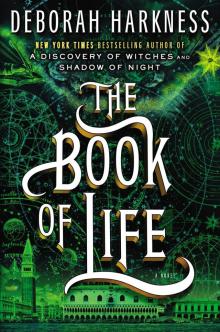 The Book of Life
The Book of Life Shadow of Night
Shadow of Night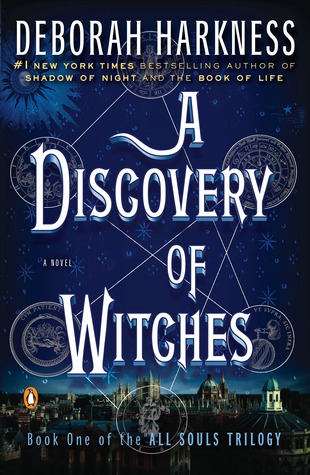 A Discovery of Witches
A Discovery of Witches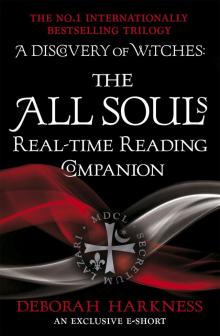 The All Souls Real-Time Reading Companion
The All Souls Real-Time Reading Companion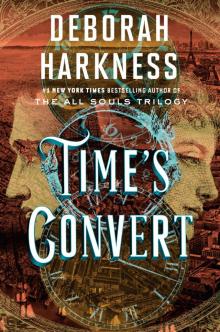 Time's Convert
Time's Convert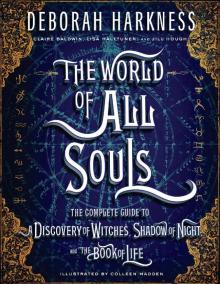 The World of All Souls
The World of All Souls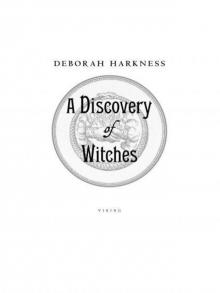 A Discovery of Witches: A Novel (All Souls Trilogy)
A Discovery of Witches: A Novel (All Souls Trilogy) Shadow of Night: A Novel
Shadow of Night: A Novel